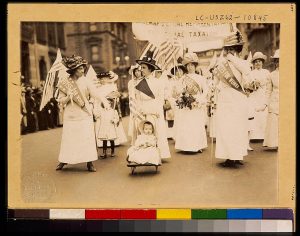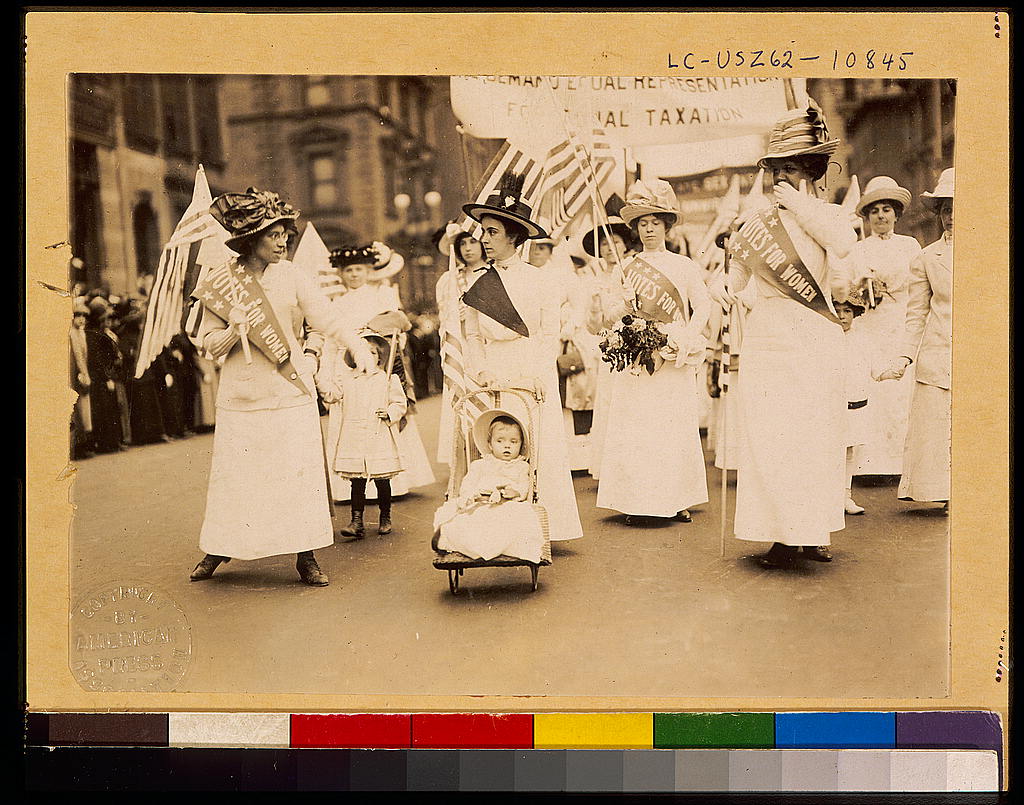
The image before you was taken on May 4th, 1912, at a women’s suffrage parade in New York City. The photo depicts a parade of women marching up 5th Avenue from Washington Square to Carnegie Hall. The parade is one of the two that took place in New York in 1912; this parade, in particular, was estimated to have 10,000-15,000 attendees. Several suffrage organizations attended both of these marches and though it is not displayed in the picture, variations of colors on marchers’ clothes denote the specific organization that they belonged to. In this image, which captured a march organized by the Women’s Political Union based in New York, the primary colors worn by the women were white. This picture is a small glimpse of the actions of women who participated in the suffrage movement, which spanned from the middle of the 19th century until the beginning of the 20th century. At this point in time, these kinds of actions, marches, and protests were methods attempting to catch the attention of as many people as possible. This event, and many like it, definitively influenced the passing of the 19th Amendment less than a decade later. This important document captures a point in time when not all Americans were afforded the same rights, but by constantly fighting in the face of adversity, those who fought for women’s suffrage would eventually achieve their ultimate goal.
In the early 20th century, women were still not granted the same right to vote as men in the constitution. Even Black men, at this time, were able to vote after the passing of the 15th Amendment in 1870; women were still cast aside in this integral facet of American society. The Seneca Falls Convention is commonly regarded as the inception of the women’s rights movement during the middle of the 19th century. In 1848, the Seneca Falls Convention was the first women’s rights convention in the US. The main goal of this convention? To address the civil and social rights that women did not have at that point in history. At that point in time, “women were not allowed to testify in court, hold title to property, establish businesses, or sign papers as witnesses.” At that time, and to no one’s shock, women’s call for a “revision of the values and laws governing relationships between the sexes” was dismissed. The women’s suffrage movement would continue for decades. Susan B. Anthony, a prominent figure in the movement and one of its leaders, would not support the implementation of the 15th Amendment, extending the right to vote to black men. Anthony believed that the 15th amendment was “a diversion from the ‘real issue’ of women’s suffrage.” However, even with this “diversion,” the suffrage movement would continue forward.
For the majority of the movement, a lot of time and energy was devoted to awareness, specifically, the first 60 years. The last 12 years of the movement saw much more action, like marches and protests. Regarding the image itself, the obvious spectacle that jumps out at first glance is the small child front and center. The child’s presence in the image can indicate several things. First, if the child is a boy, the mother can potentially introduce the child to a cause they deeply care about, or the mother may not have been able to have someone else look after the child during the march. If it is a girl, which is a safer assumption to have, the mother may have the desire to introduce her daughter to a cause that will affect her in the future. At this point, the US was still 8 years away from the 19th Amendment, so it may have seemed that the suffrage movement was still far away from achieving its goal. Furthermore, there appears to be a Black woman on the right side of the woman with the baby; they seem to be involved in some sort of discourse. Although this does seem to be the only person of color in the image, it does demonstrate that people of color and, even more to the point of this topic, women of color, were involved with the suffrage movement. Moreover, all of the individuals in the image appear to be in the middle of the street. This conveys a very organized procession, calling attention to as many people as possible since this is taking place in New York City. The suffragists’ attire seems to be very similar; all of them are wearing white dresses, white gloves, and waving flags and hats. This uniformity between the suffragists helps relay a message of unity and strength. The white attire can potentially be a sign of purity and good intentions, as white is commonly associated with the notion of youth, purity, and moral virtue. This color potentially relays the message that women would vote for politicians conducive to society. The white also helps one easily identify a suffrage advocate as wearing all white is very obvious and on your face, especially compared to the other individuals visible in the image on the left side, who appear to be wearing much darker colors. The sign “votes for women” droops over some of the women’s right shoulders and across their chests. On another note, the fact that no men are visible in the image does not necessarily indicate that men did not support the suffragist movement, as there were both supporters and non-supporters on both men’s and women’s sides.
The inclusion of a child in a women’s march can demonstrate the idea that this movement is important for those who are new to the earth. Perhaps the thinking behind these actions revolves around a new generation being exposed to fighting for what they believe in and that women’s suffrage is a worthy movement. The image of a child almost works as a passing-of-the-torch movement. An instance where a responsibility is passed from one generation to another. In a way, this woman is passing to her child the responsibility of working towards the improvement, equity, and equality of people in the United States.
Bibliography
Beck, Elizabeth L., Emily Dorsey, and Amy Stutters. “The Women’s Suffrage Movement: Lessons for Social Action.” Journal of Community Practice 11, no. 3 (2003): 13–33. Taylor & Francis Online. https://doi.org/10.1300/J125v11n03_02.
Chafe, William H. The Paradox of Change: American Women in the 20th Century. Oxford University Press, 1991.
Library of Congress. Historical photograph. Accessed November 2, 2024. https://www.loc.gov/resource/cph.3g05585/.
National Geographic. “Decoding the Symbols of the Women’s Suffrage Movement.” Accessed December 2, 2024.
https://www.nationalgeographic.com/history/article/decoding-symbols-womens-suffrage-movement.
Suffragette City 100. “57.” Accessed November 2, 2024. https://suffragettecity100.com/57.
